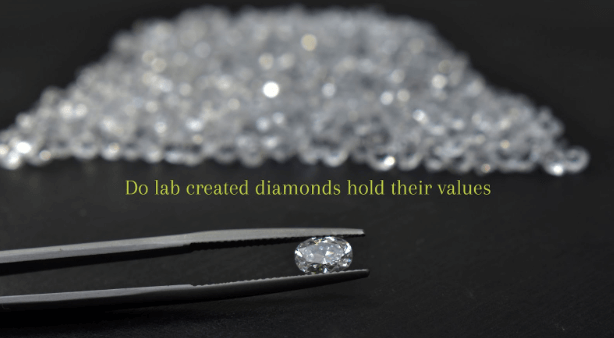Do Lab Created Diamonds Hold Their Value?

A diamond is a piece of natural carbon that is found on the earth. It is the hardest known substance and has been used for centuries to make jewelry and other ornamental objects.
As the jewelry industry continues to grow, so does the innovation within it. With new technology comes new ways of creating old favorites. Such is the case with mined diamonds. Now, instead of mining for diamonds deep within the Earth, scientists have found a way to create them in laboratories. This article will explore the process of lab created diamonds and whether they hold their value or not.
What Are Lab Grown Diamonds?
Lab grown diamonds are diamonds that are grown in a laboratory. The process of creating a lab grown diamond is similar to the way a natural diamond is formed, except it happens much faster. It can take months or even years to mine a natural diamond, but a lab grown diamond can be created in just a few weeks.
Lab created diamonds are not only cheaper than natural diamonds, but they are also ethically sourced. Because they are created in a laboratory, there is no need to mine them from the earth. This means that lab created diamonds do not contribute to environmental damage or human rights violations.
If you’re looking for an affordable and ethical alternative to natural diamonds, then lab grown diamonds are a perfect choice.
What Determines the Value of a Lab Grown Diamond?
As the popularity of diamonds continues to grow, so does the market for lab grown diamonds. These diamonds are created in a lab using advanced technology, and they have many of the same physical and chemical properties as natural diamonds. So, what determines the value of a lab grown diamond?
- Shape: When it comes to the value of a lab grown diamond, the shape is one of the key determining factors. While there are many different shapes that diamonds can come in, some are more valuable than others. The most popular and valuable shapes for diamonds are round, princess, and emerald cut shapes. These shapes tend to fetch the highest prices due to their popularity and demand. Other shapes such as marquise, pear, or oval can also be valuable, but typically not as much as the more popular shapes.
- Carat Weight: When it comes to the value of a lab grown diamond, carat weight is just one of the factors that determine its price. The other considerations include the quality of the diamond and the market demand for it.
Generally speaking, the larger the carat weight of a diamond, the more valuable it is. But there are also instances where a smaller diamond may be more valuable than a larger one. This all depends on the quality of the diamond and market demand.
For example, if two diamonds have equal carat weights, but one is flawless while the other has visible inclusions, then the former will be more valuable.
- Clarity: When it comes to diamonds, clarity is key in determining value. For lab created diamonds, this is no different. The main factor that determines the value of a lab grown diamond is its clarity. The clearer the diamond, the more precious itself.
- Color: When it comes to the value of a lab grown diamond, color is one of the determining factors. While some other things can affect value, like clarity and carat weight, color is a key element.
Those diamonds with the purest color are the ones with the highest value. These diamonds are incredibly rare, and as a result, they command a high price tag. However, even diamonds with a slight hint of color can still be quite valuable. The depth and hue of the color will affect the price, but even a diamond with a slight yellow or brown tint can be worth quite a bit.
Of course, not all colors are created equal when it comes to diamonds. Some hues, like blue or pink, are highly sought-after and, therefore, more valuable.
- Certification: When it comes to the value of a lab grown diamond, the certificate doesn’t play as big of a role as one might think. The price is mainly determined by the quality of the diamond itself. However, the certification does verify what it is you are paying for and can be used as a way to ensure you are getting what you expect.
Will Lab Grown Diamonds Hold Value?
As the market for lab grown diamonds continues to grow, so does the question of whether or not these diamonds will hold their value. The answer is a resounding yes; lab grown diamonds will continue to hold value because of the high demand for them.
More and more people are interested in buying lab created diamonds because they are more environmentally friendly and conflict-free. In addition, lab grown diamonds are just as beautiful as natural diamonds but often cost less.
When it comes to resale value, lab grown diamonds have all the same properties as mined diamonds. The “4 Cs” of diamond grading-cut, color, clarity, and carat weight-are what affect a diamond’s value. And because lab grown diamonds are created in a controlled environment, they can be produced with specific characteristics. This means that when it comes to the 4 Cs, lab grown diamonds can be better than mined diamonds.
So if you’re considering buying a lab grown diamond, don’t worry about its resale value. It will hold its value just as well as a mined diamond. In fact, because of the 4 Cs, it may even increase in value over time.
In addition, the high demand for lab grown diamonds means they will continue to hold their value over time. If you are thinking about investing in lab grown diamonds, you can be confident that you will be getting a good return on your investment.
Conclusion
Lab grown diamonds will hold value because of high demand. The reason for this is that lab created diamonds are much cheaper than natural diamonds, and they have the same physical and chemical properties. This makes them a great alternative for people who want the look and feel of a diamond without the high price tag. If you are looking for engagement rings or other pieces of jewelry, consider a lab created diamond.




